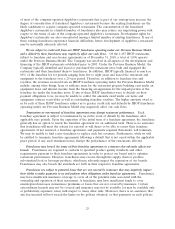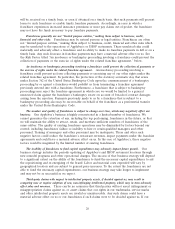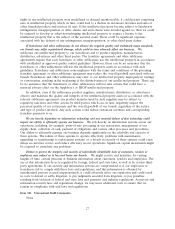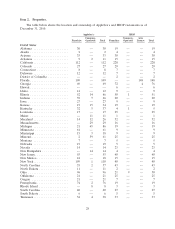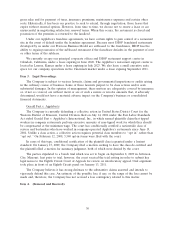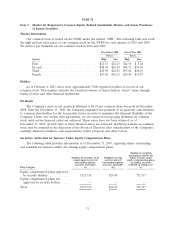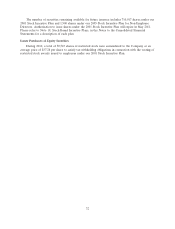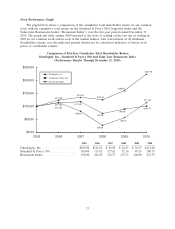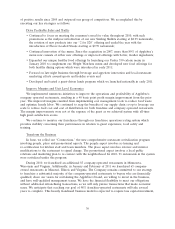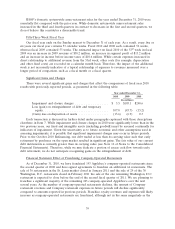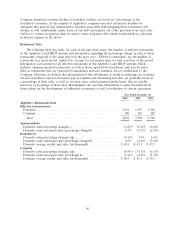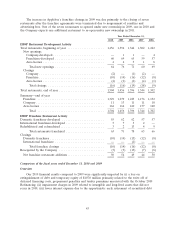IHOP 2010 Annual Report Download - page 51
Download and view the complete annual report
Please find page 51 of the 2010 IHOP annual report below. You can navigate through the pages in the report by either clicking on the pages listed below, or by using the keyword search tool below to find specific information within the annual report.Item 7. Management’s Discussion and Analysis of Financial Condition and Results of Operations.
Forward-Looking Statements
Statements contained in this report may constitute forward-looking statements within the meaning
of the Private Securities Litigation Reform Act of 1995. These statements involve known and unknown
risks, uncertainties and other factors, which may cause actual results to be materially different from
those expressed or implied in such statements. You can identify these forward-looking statements by
words such as ‘‘may,’’ ‘‘will,’’ ‘‘should,’’ ‘‘expect,’’ ‘‘anticipate,’’ ‘‘believe,’’ ‘‘estimate,’’ ‘‘intend,’’ ‘‘plan’’
and other similar expressions You should consider our forward-looking statements in light of the risks
discussed under the heading ‘‘Risk Factors’’ in Item 1A above as well as our consolidated financial
statements, related notes and the other financial information appearing elsewhere in this report and
our other filings with the SEC. The forward-looking statements contained in this report are made as of
the date hereof and the Company assumes no obligation to update or supplement any forward-looking
statements.
You should read the following Management’s Discussion and Analysis of Financial Condition and
Results of Operations in conjunction with the consolidated financial statements and the related notes
that appear elsewhere in this report.
The Company
The Company was incorporated under the laws of the State of Delaware in 1976 with the name
IHOP Corp. Effective June 2, 2008, the name of the Company was changed to DineEquity, Inc. (the
‘‘Company,’’ ‘‘we’’ or ‘‘our’’). The first International House of Pancakes (‘‘IHOP’’) restaurant opened
in 1958 in Toluca Lake, California. Shortly thereafter we began developing and franchising additional
restaurants. In November 2007, we completed the acquisition of Applebee’s International, Inc.
(‘‘Applebee’s’’) which became a wholly-owned subsidiary of the Company. Through various IHOP and
Applebee’s subsidiaries (see Exhibit 21, Subsidiaries of DineEquity, Inc.) we own and operate two
restaurant concepts in the casual dining and family dining categories of the food service industry:
Applebee’s Neighborhood Grill and Bar and IHOP. DineEquity, Inc. is the parent of the IHOP and
Applebee’s subsidiaries. References herein to Applebee’s and IHOP restaurants are to these two
restaurant concepts, whether operated by franchisees or the Company. Sales of restaurants that are
owned by franchisees and area licensees are not attributable to the Company. With more than 3,500
restaurants combined, we are the largest full-service restaurant company in the world.
Key Overall Strategies
DineEquity’s Key Strategies
At DineEquity, we have a fundamentally differentiated approach to brand management that
centers on the powerful and strategic combination of marketing, menu, operations and remodel
initiatives that creates a unique and relevant connection with our guests. Additionally, our Shared
Services operating matrix allows our brands to focus on those things that drive the business while
leveraging the resources and expertise of our scalable, centralized support structure. We believe this is
a competitive point of difference. Together, this closely integrated approach results in differentiated
brand performance that drives DineEquity’s growth and delivers results for our shareholders.
Applebee’s Key Strategies
We are in the process of a multi-year effort to revitalize the Applebee’s brand. Applebee’s
domestic system-wide same-restaurant sales increased 0.3% in 2010. This was Applebee’s first full year
35


